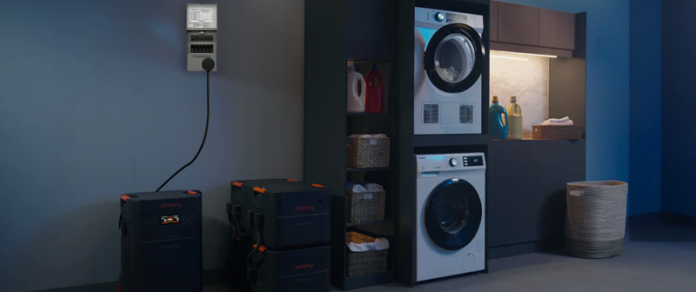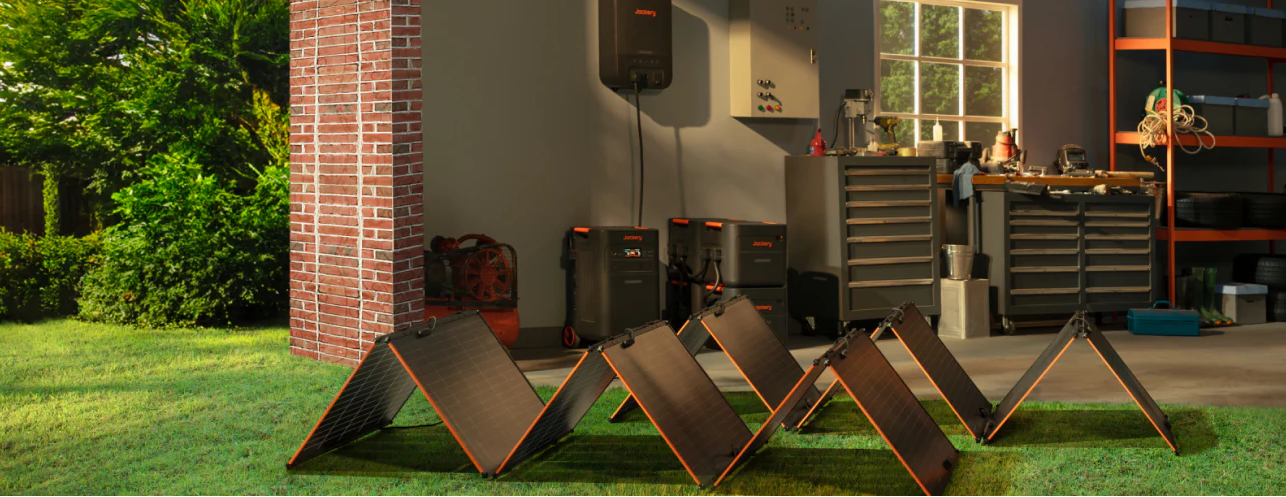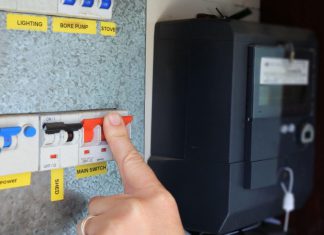The typical US electrical consumer had five and a half hours of disruptions in 2022[1]. Even brief outages may harm sensitive equipment and impair vital processes. Therefore, knowing how to operate a battery backup system is crucial. Start with constant-power devices like medical, freezers, and modems to assess your home power demands. Prioritize pure sine wave inverters for clean electricity that eliminates appliance damage when sizing your backup battery capacity. Limit simultaneous high-load device use during outages to prevent depleting the backup.
The best portable power stations, including Jackery ones, currently use LiFePO4 batteries, which are safer, last longer, and perform better in cold areas to survive lengthy power loss. Add surge protection, charge, and test your battery system since downtime is not the time to find problems.
Understanding the Basic Principles of Battery Backup Power
Battery backup systems, or UPS, store electrical energy in chemical form within batteries. They convert it back to AC power using an inverter when the grid supply fails. It is governed by solid-state circuitry that gives negligible stoppage in milliseconds. The systems may include standby, line-interactive, and double-conversion (online) types. The latter provides strong power conditioning through AC-DC-AC conversion to isolate sensitive equipment from surges or sags.
Notably, lithium-ion batteries are used over lead-acid types due to their higher energy density, charging, cycle life, and operating temperature range. However, they are costlier upfront. The cost of backup battery for house or office units might be between $300 and $5,000. However, they can be extended with additional battery packs. Moreover, battery backups have real-time monitoring, predictive analytics, and remote diagnostics. They utilize IoT connectivity to adjust performance and preempt failures.
Steps for Effective Use of Backup Batteries
-
Assess Needs
Before selecting a battery backup, conduct a load analysis to know energy demands. Identify critical systems for power during outages, including medical devices, IT servers, or refrigeration units. For example, if supporting a server rack, calculate the power draw in kilowatts and account for peak surge requirements. Next, determine the runtime for short interruptions or long outages. Energy monitoring devices or software like Eaton’s Intelligent Power Manager can be used to measure power consumption. Furthermore, voltage compatibility and power factor correction for equipment should be considered. When dealing with solar panels, verify that the battery backup supports bi-directional energy flow and matches the inverter’s specs. Oversize the battery bank for inefficiencies and aging. It gives alignment with active goals and avoids underperformance.
-
Correct Installation or Placement
Placement impacts performance and life. Install the battery backup in a temperature-controlled environment. Exciting temperatures degrade lithium-ion cells or lessen lead-acid efficiency. For instance, most lithium-ion batteries operate optimally between 10°C and 35°C[2]. If space is reserved, use wall-mounted units with ventilation. Besides, maintain clearance around the system for heat dissipation and servicing. Ground the system to stop electrical hazards using an earthing wire conforming to NEC Article 250. Connect the battery backup to surge protection devices to shield it from transient spikes. For outdoor installations, use weatherproof enclosures rated at least IP65. Check interconnection standards with local utilities if planning grid-tied configurations. Correct placement boosts safety and regulatory compliance.
-
Test the Battery
Testing confirms that the battery backup delivers during outages. Execute a load bank test to simulate real-world conditions and discharge performance. Fluke Power Quality Analyzers detect voltage or current delivery irregularities. Test internal resistance since rising resistance may signal impending failure. For lithium-ion batteries, BMS monitors temperature, SoC, and SoH. Lead-acid systems need electrolyte level checks. Use hydrometers for specific gravity values. Sensors within the system must also be calibrated for accurate readings. After testing, document performance metrics for trend analysis. It gives readiness and extends system life.
-
Use Reasonably
Resourceful use of battery backup lengthens active life and averts premature degradation. Connect only essential devices. Overloading decreases runtime and risks over-discharging. Utilize automated transfer switches to manage load priorities. For systems supporting renewable energy, charge batteries during low-demand periods or peak solar production hours for grid independence. Avoid deep discharges for lead-acid systems because they prompt sulfation. Instead, keep a discharge depth of 50% or less. For lithium-ion batteries, limit charge cycles and operate within a safe SoC range. Implement demand response systems to scale energy use per backup capacity. Additionally, software-based controls should stagger the activation of heavy equipment. Henceforth, you can exploit runtime efficiency and lifecycle performance.
-
Proper Storage and Maintenance
Store battery backup systems to preserve chemical and structural reliability. Lithium-ion systems should be stored at around 40%[3] to decrease cell stress. Lead-acid batteries must be fully charged to avoid sulfation. Keep temperature stability with climate-controlled environments in long-term storage. Inspect connections for corrosion. Clean terminals with baking soda and distilled water to neutralize acidic deposits. For flooded lead-acid batteries, top up with distilled water. Thermal cameras detect hotspots that indicate overcurrent or faulty cells. Update firmware on BMS systems to stay compatible with energy protocols. Rotate inactive battery units into use to avert stagnation. A recycling plan with EPA guidelines for responsible disposal should be accepted in the long term. Maintenance ensures your battery backup is reliable for years.
Battery Backup Usage Guide for Different Types of Appliances
-
Lighting and Sockets
When using a battery backup for lighting and sockets, employ devices with lower wattage to spread runtime. LED lights consume less power than incandescent or fluorescent bulbs. For sockets, consider the cumulative load. High-power heaters or hair dryers can drain the battery, but this must be avoided. Use a surge-protected outlet with the battery backup to stop voltage spikes, which can harm the connected appliances. Also, check if your battery backup supports sine wave output. Non-sine wave inverters can cause buzzing or cut the life of LED lighting.
-
Refrigerators and Freezers
A refrigerator or freezer needs a battery backup handling high inrush currents. They may draw higher than their running power during startup. So, select a backup system with a peak power rating above the steady-state consumption. E.g., a fridge running at 150 watts may demand a backup rated at 800-1000 watts for operation. Plus, the battery should have enough capacity to support lengthy outages. A 2-kWh battery can power a standard refrigerator for up to 10 hours. To conserve battery life, avoid recurrent door openings, which force the compressor to run more.
-
Kitchen Appliances
Microwaves, coffee makers, and induction stoves demand management when using a battery backup. They might need pure sine wave inverters to function without noise or overheating. Assess the combined wattage and choose a battery with a headroom over the total load. For instance, a 1200-watt microwave can pair with a backup rated for at least 1600 watts. Apart from that, stagger usage inhibits overloading the system. High-consumption appliances should run one at a time to capitalize on the battery’s life and circumvent tripping the inverter.
-
Computers and Network Equipment
A battery backup with an AVR feature tackles power fluctuations in computers and network equipment. Electronics need a stable voltage supply to avoid data corruption or hardware failure. Opt for a UPS with a runtime to fail over to another power source. Lithium-ion batteries are used for their lightweight and longer life. E.g., a 600 VA UPS might power a desktop PC and router for up to 30 minutes. Further, the system must be tested so data is protected during outages.
-
Medical Equipment
Oxygen concentrators or CPAP machines count on a battery backup. Many devices have specific continuous wattage and clean sine wave output. For instance, an oxygen concentrator rated at 400 watts would need a battery system with at least 500 watts of nonstop output. What is more, redundancy is key. Consider dual-battery setups for uninterrupted operation. Portable lithium-ion power stations are good due to their high energy density. Consult the medical device manual for compatibility guidelines and complete testing for readiness during emergencies.
-
Electric Vehicle Charging
Charging an EV using a battery backup is feasible. Yet, it needs planning. EV chargers may operate at high power levels. E.g., Level 1 chargers may draw about 1.4 kW, and Level 2 chargers up to 7.6 kW. So, a large-capacity battery backup system is necessary for even partial charging. Likewise, the system supports high current output and thermal management to thwart overheating. During long outages, limit charging to essential levels to conserve backup energy. Solar panels with a battery system can augment sustainability and charging availability.
Precautions for Protecting Appliances
Use Dedicated Lines
Connect your battery backup system to dedicated circuits for appliance safety during power outages. To avoid undue voltage drops or interference, the lines must be isolated from high-load HVAC units. Dedicated lines cut EMI, which can damage servers or medical devices. E.g., running a refrigerator and a computer on the same line risks voltage spikes when the compressor cycles. Use surge suppressors and line conditioners with dedicated circuits for stability.
Correct Connection
Correctly integrating a battery backup system is key to performance. Incorrect wiring can trigger reverse polarity, which may damage appliances. Use the manufacturer’s connectors and evade generic or third-party cables unless they match the specs. Also, connections to inverters must be tight and corrosion-free to avert overheating. Misaligned phases between the backup system and your appliances can create harmonic distortion, which may degrade motors or transformers.
Avoid Overloading
Overloading a battery backup can prompt system or appliance damage. Check the backup’s wattage rating. It should match the combined load of connected devices. For example, connecting a 1000W load to a 750W-rated battery backup can cause overload shutdowns and influence battery life. Use load calculators and separate high-power appliances from critical electronics. Plus, circuit breakers with amp ratings help cut power during surges.
Avoid Prolonged Discharge
Lengthy deep discharges can degrade the battery cells and their life in backup systems. Most batteries have a cycle rating. Excessive discharge beyond the depth of discharge(DoD) limit lessens their efficiency. For instance, a lead-acid battery for 50% DoD may fail if discharged to 80% often. Implement low-voltage cutoff to disconnect appliances when battery levels drop below safe thresholds. Further, routine maintenance should be scheduled to recalibrate battery performance metrics.
Ventilation and Heat Dissipation
Battery backups generate heat during operation under heavy loads. Without ventilation, internal components risk thermal degradation. Place the battery backup in a well-ventilated area away from direct sunlight or enclosed spaces. E.g., an inverter operating at 85% efficiency may produce waste heat and need cooling. Install fans or passive cooling systems to keep working temperatures. Heat may also create fire-prone lithium-ion battery thermal runaway.
What Is The Best Portable Power Station?
Jackery Solar Generator 5000 Plus: Performance and Advantages
The Jackery Solar Generator 5000 Plus is a battery backup for reliability during power outages. Its 5-60kWh capacity and 7200W dual-voltage output (120V/240V) deliver power for appliances, including high-energy household devices and gentle electronics. It has a near-instant 0ms UPS switchover to safeguard servers and routers. Over 4000 cycles and 10 years of everyday usage are possible with the LiFePO4 battery. ChargeShield 2.0 technology heightens charging efficiency. Its hybrid charging system (solar, AC, and transfer switch) gives adaptability. With app control, users can track power usage and adjust performance in real-time for tough scenarios.
Appliance Compatibility: What Can Be Powered
Essential Appliances:
Refrigerators, HVAC systems, medical ventilators, sump pumps, and emergency lighting.
Luxury and High-Energy Appliances:
Electric ovens, coffee makers, induction cooktops, washers, dryers, and water heaters.
Charging EVs:
Level 1 EV chargers, maintaining a charge for light to medium-range trips.
Smart Devices:
Routers, home servers, laptops, gaming consoles, and smart TVs.
Tools and Outdoor Equipment:
Electric drills, lawnmowers, high-powered vacuums, and pressure washers.
Final Words
So, battery backup systems must be appropriately used and maintained to protect US home appliances during power outages. Assess your power demands, identify key appliances, and choose a house battery backup solution with enough capacity and duration. Choose pure sine wave inverters for clean electricity and electronics protection. Install the system in a cool, dry, well-ventilated environment with correct grounding and surge protection.
Check system operation and battery health regularly. Connect only necessary equipment to the battery backup to prevent overloading it. Limit deep discharges and check battery temperature to avoid damage. Maintain the system by cleaning terminals, monitoring electrolytes, and adjusting sensors for performance and lifetime. Following these rules could improve your battery backup system’s efficacy and protect your important equipment during power outages.
Reference
- U.S. electricity customers averaged five and one-half hours of power interruptions in 2022. Available at: https://www.eia.gov/todayinenergy/detail.php?id=61303 (Accessed: 18 December 2024)
- Review Of Comparative Battery Energy Storage Systems (Bess) For Energy Storage Applications In Tropical Environments. Available at: https://www.researchgate.net/figure/Optimal-operating-temperature-of-Li-ion-battery-26_fig3_327966044 (Accessed: 18 December 2024)
- BU-702: How to Store Batteries. Available at: https://batteryuniversity.com/article/bu-702-how-to-store-batteries (Accessed: 18 December 2024)
















